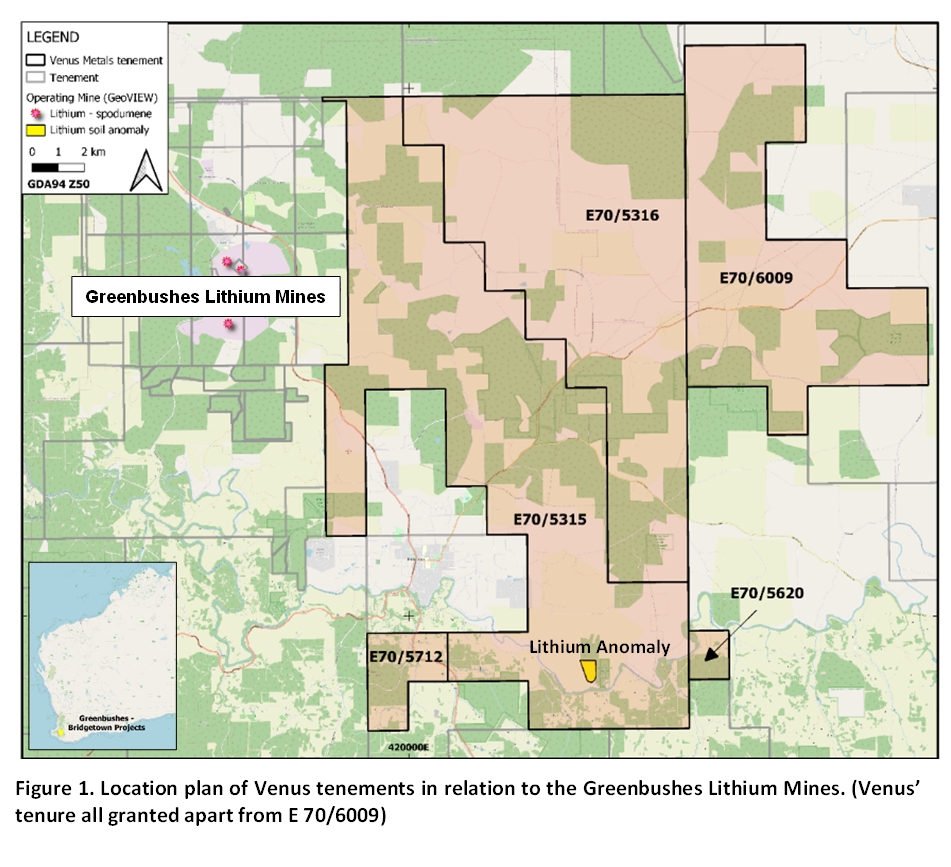PROJECT BACKGROUND
VMC’s Greenbushes East Lithium and Bridgetown East Ni‐Cu‐PGE Projects comprise five granted tenements held by Venus Subsidiary, E70/5315, E70/5316, E 70/5620 and E70/5712, E 70/6009 (Venus Subsidiary) and one exploration application, E 70/5675 (VMC) outside of map area of Figure 1.
GREENBUSHES EAST LITHIUM PROJECT
Targets for potential LCT - rare metal pegmatites. The western boundary of the VMC and Venus Subsidiary tenure abuts the Greenbushes mining leases (Figure 1). Geological mapping and reconnaissance surface sampling by VMC within an area of potassic alteration (>9 km2 ) located pegmatite outcrops with one pegmatite sample returning 0.28% Li2O (refer ASX release 26 June 2017). Systematic geochemical surveys across the western part of E 70/5315 are planned to identify potential LCT targets under soil cover.
IGO FARM-IN & JV AGREEMENT:
Venus Metals Corporation Limited (“VMC”) subsidiary ("Venus Subsidiary") has entered a binding transaction with a subsidiary (“IGO Subsidiary”) of IGO Limited regarding exploration and, if warranted, development and mining at its Bridgetown Greenbushes Exploration Project ("Project"). IGO holds a 49% interest in a global joint venture with Tianqi Lithium Corporation. The joint venture has a 51% interest in the Greenbushes Lithium Mine. The Farm-in and Joint Venture is one in which IGO Limited Subsidiary can progressively acquire up to a 70% interest in the Bridgetown Greenbushes Exploration Project by incurring A$6,000,000 of exploration expenditure. The IGO Subsidiary will solely fund all Joint Venture expenditures until the completion of a pre-feasibility study in relation to the Project. If IGO Subsidiary completes a pre-feasibility study, it has the right to acquire Venus Subsidiary's 30% interest in the Project for a price based on fair market value. Should IGO Subsidiary elect not to acquire the 30% interest, the parties will continue to be associated in an unincorporated joint venture under which the IGO Subsidiary must use reasonable endeavours to market and process all Joint Venture products, including Venus Subsidiary's share.
Phase 1 Stream Sediment Sampling
Collecting and analysing stream sediment samples are commonly used geochemical exploration methods in areas with well-developed drainage systems. A drainage model for the Bridgetown area was used to design a program covering 114 roadside stream sediment sampling points across the entire Project area. The survey was designed to identify prospective catchments that have the potential to contain lithium-bearing rare metal pegmatite indicator minerals. The mineralogy of each stream sediment sample was determined using automated TESCAN Integrated Mineral Analyser (TIMA) analysis.
Spodumene grains were identified in two samples (SWT001519, SWT001547). Results from these two samples were also verified via Laser-Induced Breakdown Spectroscopy (LIBS), confirming the chemical composition of spodumene in both samples as well as columbite-tantalite and cassiterite in one of the samples. The two samples are from different areas, referred to as the Cowslip and Flying Duck target areas. refer ASX announcement 17/09/24
Phase 1 Soil Sampling
A total of 1,588 surface soil samples were collected across the project area as part of the reconnaissance Phase 1 sampling programme (Figure 2). Most soil samples were collected from road reserves. More extensive grid sampling was restricted to areas in the southeast section of the tenement E70/5315.
The soil geochemistry outlined several broad anomalous areas defined by elevated concentrations of indicator elements Li-Nb-Sn-Ta ±W (Figures 5,6,7,8). Two areas, Ti Tree and Greenbushes East, have been selected for priority Phase 2 follow-up soil sampling. Detailed interpretation of results from Phase 1 and 2 will begin upon completion of Phase 2 and receipt of assay results.
Further Work
Follow-up Phase 2 work programs aim to validate the areas of interest and determine whether the presence of spodumene +/—cassiterite and columbite-tantalite in stream sediment samples is derived locally from rare metal pegmatites within the immediate catchment areas or if it may be derived from a source external to local catchments.
IGO will also conduct a ground gravity survey across the same properties targeted by the soil sampling campaign over the coming months. This survey is expected to guide subsurface geological interpretation and will be used in conjunction with soil geochemistry to target rare metal pegmatite
systems.
